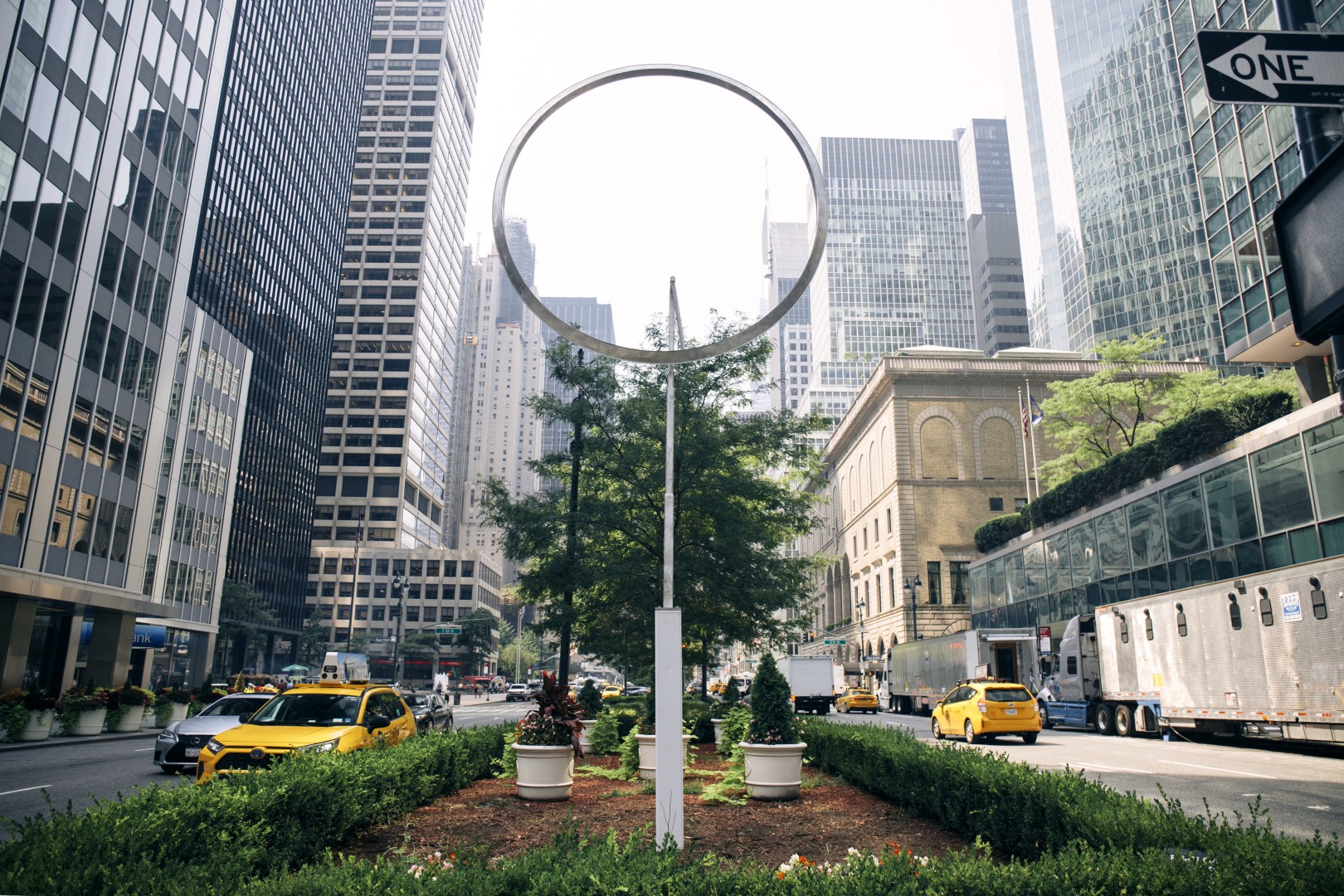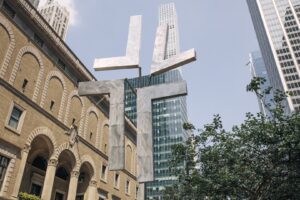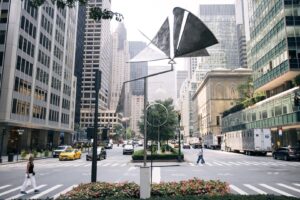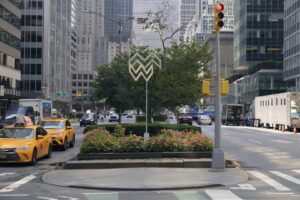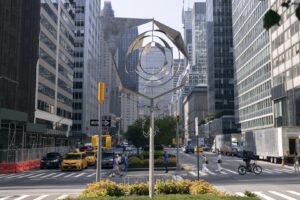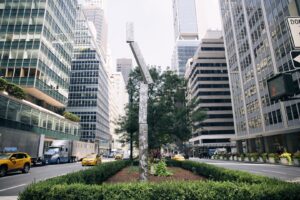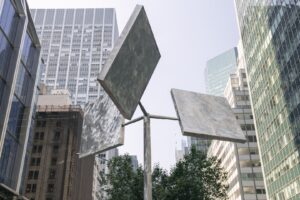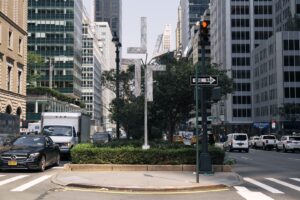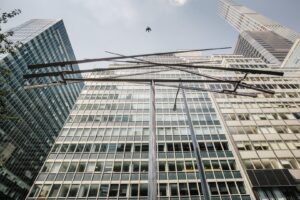Perfectly timed with the publication of the first biography on the famous sculptor, the exhibition “George Rickey Sculpture on Park Avenue, New York, New York” is being currently staged in collaboration with The Fund for Park Avenue and the NYC Parks’ Art in the Parks program and will be on view to November 2021. It features nine of Rickey’s classic, large-scale kinetic sculptures, some of them not exhibited in many years. Carefully placed along the median of Park Avenue from 52nd to 56th street, these enormous sculptures weigh 300 to 1,500 pounds each and tower up to 25 feet in the air, almost three stories high.
Rickey was one of two famous 20th-century artists known for kinetic sculpture, the other being Alexander Calder. According to the Rickey Foundation, “Taking Calder’s mobiles as his starting point, Rickey combined his artistic and engineering skills to create complex types of movement, utilizing harmonic and gyratory motion to expand the dynamic potential of kinetic art.” Rickey said that “motion, which we are all sensitive to, which we are all capable of observing without having to be taught, is a sensation that appeals to the senses just as color does.
“The timing of this exhibition is special as 2020 was the 20th anniversary of the founding of the Fund for Park Avenue’s Sculpture Advisory Committee and the first sculptor we elected was George Rickey,” said Barbara McLaughlin, President of The Fund for Park Avenue. The Fund works closely with NYC Parks’ Art in the Parks Program to present a variety of temporary sculpture exhibitions on the Park Avenue Malls. “It is also a heart-warming welcome to people coming back to the city after the pandemic and a great way to support the sense of community,” McLaughlin added.
One of the most heartwarming aspects to this impressive exhibition is the Ricky Foundation’s focus on children. They have created a webpage on their site dedicated to reaching out to “kids.” They ask questions that kids can think about for each of the sculptures and how it relates to kinetic movement.
This idea (Rickey Kids) was conceived of and developed by Lisa Beth Podos with the assistance of Maria Lizzi, Amanda Perry, Victoria Petway, and Hilary Vlastelica. Here is an example of a question for the kids.
This artwork is made of three squares which move with the slightest breeze, so the piece is continually changing. Look at the surface; do you see any reflections? Colors? Anything else? While this sculpture looks simple, it’s surprisingly not! Pretend you are a Rickey sculpture, and make your arms like metal lines moving in the wind. Try moving them back and forth; now move them around in circles. Which way do the squares in this sculpture move?
Rickey’s works can be found in major museums throughout the world, including The J. Paul Getty Museum, Los Angels, CA; Solomon R. Guggenheim Museum, New York, NY; Hara Museum of Contemporary Art, Tokyo, Japan; The High Museum of American Art, Atlanta, GA; Los Angeles County Museum of Art, Los Angeles, CA; The Metropolitan Museum of Art, New York, NY; The Museum of Fine Arts, Dallas, TX; The Museum of Modern Art, New York, NY; The National Gallery, Edinburgh, Scotland; The National Gallery of Art, Washington D.C.; New Orleans Museum of Art, New Orleans, LA; Ruckversicherungs-Gesellschaft, Munich, Germany; Tate Gallery, London, England and the Whitney Museum of American Art, New York, NY. Much of Rickey’s work was created in his studio in East Chatham, New York, where he settled in 1960. He grew up in Scotland and Britain and during his lifetime had offices in Santa Barbara, California and Berlin, Germany.
The 475-page biography on Rickey, titled George Rickey: A Life in Balance by Belinda Rathbone, is published by David R. Godine. According to the Godine website, George Rickey: A Life in Balance follows the life of a renowned artist?first a painter, then a sculptor?who found inspiration all around him?as a child visiting the Singer Sewing Machine factory managed by his father; in his adventurous youth in the London and Paris art studios of the 1920s; and as an engineer in the Army Air Corps during World War II.
The author skillfully tells the story of Rickey’s life in the larger context of the twentieth century: from Depression-era America to the upheaval of World War II, to the rise of New York as the world’s art capital at mid-century and then the tumultuous 1960s, when Rickey emerged as an international figure. It is also the story of an exceptional marriage and of Rickey’s charismatic, devoted wife, Edith Leighton, who managed her husband’s career and reputation in the high-powered art circles of New York, Berlin, and Los Angeles.
Coordinating with the Park Avenue exhibition, the Kasmin Sculpture Garden in Chelsea (right underneath the High Line at West 27th Street) is hosting three more of Rickey’s important works. The Kasmin Gallery represents the George Rickey Estate that brings his art to new audiences and supports the goals of the George Rickey Foundation which include supporting and providing technicians who were trained by Rickey adjust, repair, and restore his works for private clients, auction houses, and public institutions.
According to Kasmin Gallery’s website, “George Rickey spent over five decades committed to the creation of poetic and precisely-calibrated sculptures that he referred to as his “useless machines.” Designed to be situated in the public sphere, the works are activated by their interplay with the surrounding environment, reshaping the landscape and bringing heightened attention to aspects of light, movement, and composition.” The fact that they now are displayed out of doors in New York City is probably a most perfect setting for this three-dimensional art that moves.
The Fund for Park Avenue is the NYC non-profit organization responsible for planting and maintaining the trees and flowers on the Park Avenue Malls between 54th and 86th Streets through their Park Avenue Malls Planting Project. The Fund also manages the annual Park Avenue Tree Lighting. Both programs are made possible solely by annual contributions made to The Fund for Park Avenue.
For more than 50 years, NYC Parks’ Art in the Parks program has brought contemporary public artworks to the city’s parks, making New York City one of the world’s largest open-air galleries. The agency has consistently fostered the creation and installation of temporary public art in parks throughout the five boroughs. Since 1967, NYC Parks has collaborated with arts organizations and artists to produce more than 2,000 public artworks by 1,300 notable and emerging artists in more than 200 parks.
All of the photographs of works on Park Avenue are by Diego Flores, courtesy of Kasmin Gallery.
By Victoria Larson, Editor, Side of Culture
VK Larson Communications

